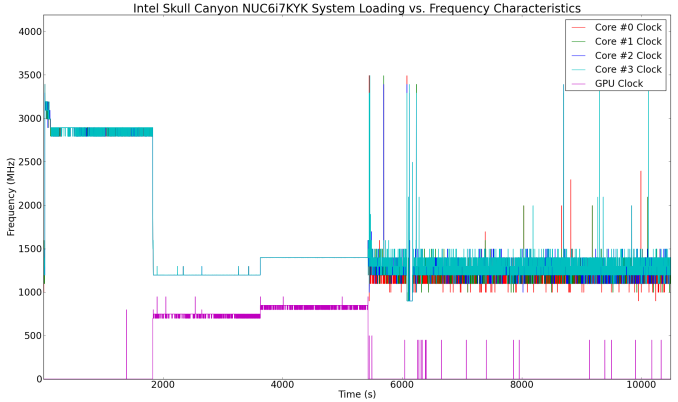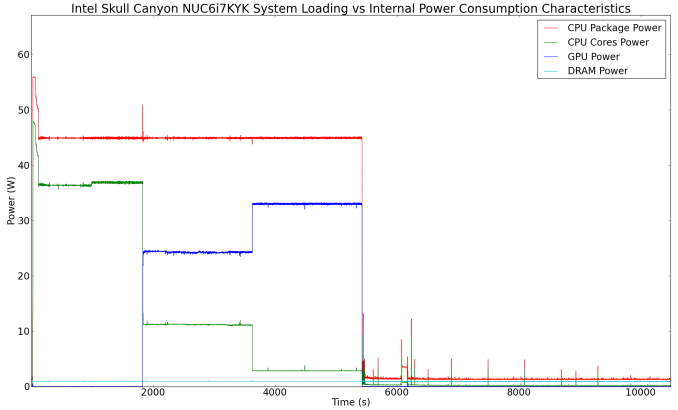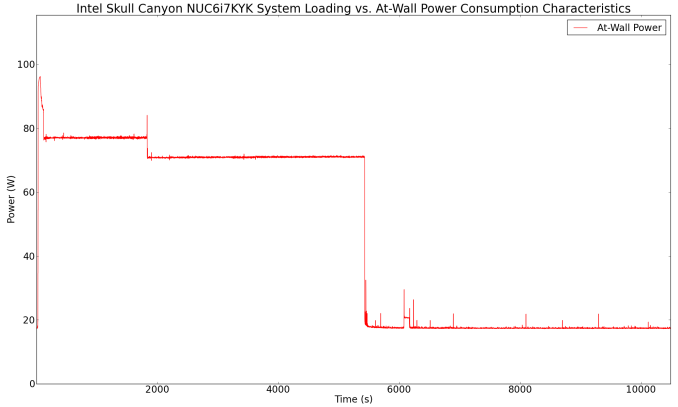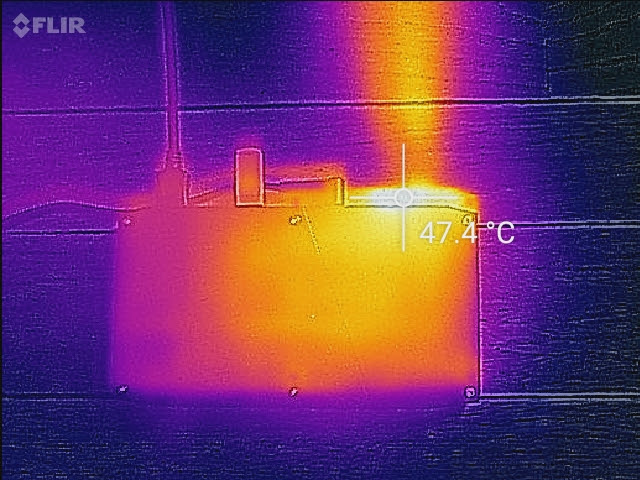The Intel Skull Canyon NUC6i7KYK mini-PC Review
by Ganesh T S on May 23, 2016 8:00 AM ESTPower Consumption and Thermal Performance
The power consumption at the wall was measured with a 1080p display being driven through the HDMI port. In the graphs below, we compare the idle and load power of the Intel NUC6i7KYK (Skull Canyon) with other low power PCs evaluated before. For load power consumption, we ran Furmark 1.12.0 and Prime95 v27.9 together. The idle number is a bit disappointing, though, I assume that a change in the BIOS to the low power profile could help improve things. Otherwise, the idle number is just slightly higher than what is typical for a system with a 45W TDP CPU and a PCIe M.2 SSD.


The load power number in the graph above is the maximum sustained value. As we can see from the graphs below, instantaneous peak numbers can go as high as 95W. Addition of bus-powered USB devices will also tend to drive up this number further.
Our thermal stress routine starts with the system at idle, followed by 30 minutes of pure CPU loading. This is followed by another 30 minutes of both CPU and GPU being loaded simultaneously. After this, the CPU load gets removed, allowing the GPU to be loaded alone for another 30 minutes. The various clocks in the system as well as the temperatures within the unit are presented below.
The graph below present the power consumption profile of various blocks in the CPU package during the course of our thermal stress. Following that, we have the power consumption at the wall for the system during the same period.
According to the official specifications, the junction temperature of the Core i7-6770HQ is 100 C. Unfortunately, the cooling solution is not able to prevent the CPU from hitting it with turbo speeds activated. However, the frequency does remain above the base 2.6 GHz throughout the pure CPU loading segment. The package power settles down to a steady 45W, and that continues throughout the duration of our test. Our only concern is that the cooling solution keeps the temperature of the cores too close to the junction temperature during periods of heavy CPU load. Once the load gets distributed across both the CPU and the GPU, we see the package come down to around 90C.
Another important aspect to keep note of while evaluating mini-PCs is the chassis temperature. Using the Android version of the FLIR One thermal imager, we observed the chassis temperature after the CPU package temperature reached the steady state value in the above graph.
We have additional thermal images in the gallery below.
The maximum chassis temperature observed by the thermal imager was slightly above 60 C near the fan's exhaust vent. At that point, a sound level Android app running on the HTC One M7 recorded 59 dB. For comparison purposes, the Zotac ZBOX MAGNUS EN970 recorded 50 dB in a similar scenario.







_thumb.jpg)

_thumb.jpg)

_thumb.jpg)









133 Comments
View All Comments
spikebike - Monday, May 23, 2016 - link
Anyone know why the GB-BXi5G-760 is so slow? The spec looks pretty similar to the EN970 (same gpu), to performs radically worse on all the games.Calista - Monday, May 23, 2016 - link
Was it not related to heavy throttling? Like *really heavy* throttling.trane - Tuesday, May 24, 2016 - link
Pleasantly surprised by the GPU. Pretty damn good, around the same as a 750 Ti.tipoo - Wednesday, May 25, 2016 - link
I thought it would be more to be honest. Looks like the size of the heatsink is limiting it. It's good, but at nearly double the EUs of the already ok Iris Pro 5200 in my Haswell machine, I expected the 72 EU to do better than this.potf - Tuesday, May 24, 2016 - link
Missing Noise levels in anandtech reviews, with the thermals ?The product maybe has a target, which is not me, but the problem with the mini pc reviews at anand is that we only get 1 or 2 little measurements on the fan noise, and in the skull canyon Nuc, I think it's disappointing, as you mention it in the final comment
> " We would gladly trade a modest increase in the footprint of the system for lower fan noise. That said, the fan noise is in no way comparable to the BRIX Gaming lineup. It is just that it is not as silent as the traditional NUCs."
For example, measuring noise at idle, at gpu / cpu loads, and getting a noise comparison at these points would be useful : the thermals are very nice, but you cannot compare them really/easily from one pc to the other.
My point is that with the current idle power at 17 watts in your test, this racehorse nuc is never ever silent or even quiet, but I would like to see comparisons with the other nucs or at least the MSI cubi 2 recently reviewed.
Also curious about the noise level of the asus VC65 / VC65R relative to that of the Skull Nuc ;), what I mean is that the chosen form factor can be either optimal, or poorer than other 35W-45W solutions.
Will we be getting noise comparisons betwen PCs in a nice chart soon ?
Osamede - Tuesday, May 24, 2016 - link
I'm asking: what is the use case that Intel are targeting and marketing to? Is it 1080P?milkod2001 - Tuesday, May 24, 2016 - link
I'd say the only NUCs which make sense to buy are the cheapest options(not the one reviewed here). Good enough for office work, youtube, Facebook and internet browsing.For gaming or serious work laptop or mini ATX build will give user much much more than this overpriced fancy NUC
rhx123 - Tuesday, May 24, 2016 - link
So disappointed. I was really looking forward to this product, but the PCIE/DMI Situation is incredibly silly. Must be intentional, but why?Such a waste.
Femton - Tuesday, May 24, 2016 - link
What is your comment to jasonelmore who earlier ( Monday, May 23, 2016) that "it will work fine. Intel has been using the Razer External GPU Chassis and they even commented on it here on Anandtech Comments, on the last article that was posted about it. DMI 3.0 still does 4GB/s and the CPU is not transferring huge amounts of bandwidth hungry texture data back and forth with the CPU." ?Osamede - Tuesday, May 24, 2016 - link
Noise focus is something that has been a weakness here for some time. And not much awareness from the folks who run this place about it.SPCR is a better place to find what you are asking about. Intel is one of their sponsors, so no doubt they'll have a review up before long.